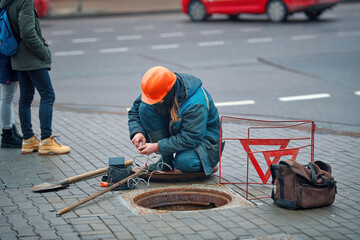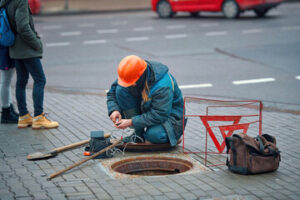Aurora Plumbing is a crucial part of building infrastructure that ensures occupants have access to clean water and can safely dispose of wastewater. It’s important to understand the role plumbing plays and how it differs from drainage systems.
While plumbing myths make for interesting blog topics, they can also lead to disastrous consequences. For example, putting cooking fat down the drain can cause blockages.

Drainage is the system that removes waste water from sinks, bathtubs and toilets into the sewer pipes. This waste contains food particles, cleaning products, and sewage, which can all be dangerous if they enter your drinking water supply. Drainage also includes the pipes that carry wastewater away from your home. The most common materials for drainage pipes are GI, HDPE, and CPVC. They are installed underground or in the ground and can be run horizontally or vertically. They are usually laid on a slope so they can transport the waste down to the municipal sewer or septic tank.
The drainage system utilizes gravity’s natural force to help the waste move along the pipes until it is removed from your property. It is also designed to keep debris and solid wastes from entering the drain system. This is done by installing a trap for each fixture. The trap is a curved section of pipe under the drain that works much like the S or P-traps found under sinks. The trap keeps sewer gasses from entering the house and also helps to prevent clogged drains.
Each trap is fitted with a vent pipe that allows fresh air to enter the drain system. The venting system also ensures that any siphoning or back pressure won’t affect the drainage pipes. For this reason, it is important that each drain is properly sized to handle the maximum drainage load of the building.
Where a piping system has more than one change of direction within 40 feet (12 192 mm) of developed length, a cleanout shall be provided at each change of direction. This cleanout will enable the removal of any obstructions from the drainage system without opening the cover of a manhole.
If you’ve ever smelled sewer gas, it’s likely that the standing water in the drain traps has evaporated and allowed the gases to enter your home. If this happens, you’ll need to run water at every tap and flush all the toilets until the traps are full again. You can also hire a plumber to clean out the traps and make sure they’re working correctly.
The water supply system brings fresh water into your home. This includes pipes, valves, and connections that bring in drinking and cooking water from your local municipal or private water supply. It also includes the water supply lines and pipes that branch out to your showers, sinks, toilets and other fixtures throughout the house. Water supply systems are usually pressurized to ensure that the water is delivered at a consistent rate and to the correct pressure level for each fixture.
Public utilities run most water supply systems. They are designed to provide water for residential, commercial and industrial purposes, as well as public needs such as street flushing and firefighting. Water supply systems may include underground pipes or aboveground reservoirs and cisterns. They can also include pumps to boost the pressure of water or additional pressurizing components. These systems may also connect to sewers, but the sewer system is considered a separate plumbing system.
Water supply is different from irrigation, which refers to the practice and systems of watering on a larger scale for a variety of agricultural uses. Water supply and irrigation are closely related in terms of the water they transport and use, but they serve very different purposes.
Your water supply line, which is sometimes called the building water distribution system, carries potable water from the water main to your house and any other buildings on your property. The water service pipe begins at the meter at the street and ends at your water meter inside your house, or wherever you install it. It should have a water meter and main shut-off valve, which are typically located on the street side of your house in a basement or crawl space.
A water service line can be made of a variety of materials, but most modern systems use polymer (plastic) tubing. These types of tubing offer the best combinations of safety, durability, ease of installation, longevity and value. They are also available in a wide range of nominal tubing sizes to fit any water demand. Crosslinked polyethylene (PEX) and specific types of raised temperature polyethylene (PE-RT) tubing are commonly used for water service lines.
Plumbing involves installing, repairing and maintaining water supply lines, sewerage, drainage, and venting systems. Plumbers use various tools and materials to perform their jobs, including pipe wrenches, pipes, plumber’s putty, access panels, air compressors, and more. Plumbing also includes the installation and maintenance of water heaters and other equipment used for heating and cooling buildings.
Because plumbers deal with human waste, they are at risk of contracting infectious diseases such as cholera, typhoid, hepatitis and others. It is important for them to follow strict safety procedures when dealing with human waste and sewage systems. They must also wear protective clothing and masks when working with sewage pipes.
The system typically comprises a network of wet wells, head manholes, pumps, force main links and junction chambers. Flow, water head and capacity data are collected at these points in the system. A program solves the network hydraulics to get the n1 wet well head and n2 head and tail manhole water heads, and to determine n3 pump heads, n4 force main links and n5 junction chamber flows.
While the piping can be made from a wide variety of materials, it is important to select pipes that can resist degradation from corrosion and other damage. This is especially true of the wet wells, where a high concentration of hydrogen sulfide and other oxidants can attack the pipe.
A functional air system is also essential in force mains to keep the pipeline full of sewage and prevent air pockets, which can lead to severe damage. This requires periodic inspections and testing, as well as the installation of air valves at strategic points throughout the system.
The good news is that it is now easier than ever to assess the condition of a force main, even without taking the system out of service for a visual inspection. Utilities can leverage advanced technology, such as smart-ball testing, to collect actionable information that identifies potential hot spots in the system. This can help to identify problems, which can then be prioritized for repair, enabling the utility to avoid high consequence failures and mitigate risks. This can help to lower capital expenditures and increase confidence in the operation of this vital infrastructure.
All of your home’s drains and pipes are connected to the main sewer line. This vital pipe is responsible for taking wastewater and sewage away from your home, carrying it to the public sewer line in the street and then to the local sewage treatment plant.
Sewer systems are designed for ease of operation and maintenance. They usually include relatively small-diameter pipes that are buried under the ground and constructed of vitrified clay, asbestos cement or concrete; cast iron or steel for larger systems; or ductile iron for force mains. Joints between pipe sections must be tight enough to prevent leakage of sewage or groundwater into the pipeline, and access points called manholes are located periodically over the lines for cleaning, inspection and repair.
Since sewage is carried downhill by gravity, the main sewer lines are often routed in low-lying areas to minimize their elevation above grade. When the line reaches its destination, it’s pushed through a series of increasingly larger pipes until reaching the treatment plant. For buildings that do not connect to the main sewer, pumps or lifts may be used to move the wastewater.
Clogged, or “backed up” sewer lines are a common and dangerous problem. While some clogs are caused by grease, soap scum and hair that find their way down drains, many are the result of improper use or care of plumbing fixtures and drains. The best defense against a clogged sewer line is to know the warning signs and practice preventative maintenance.

